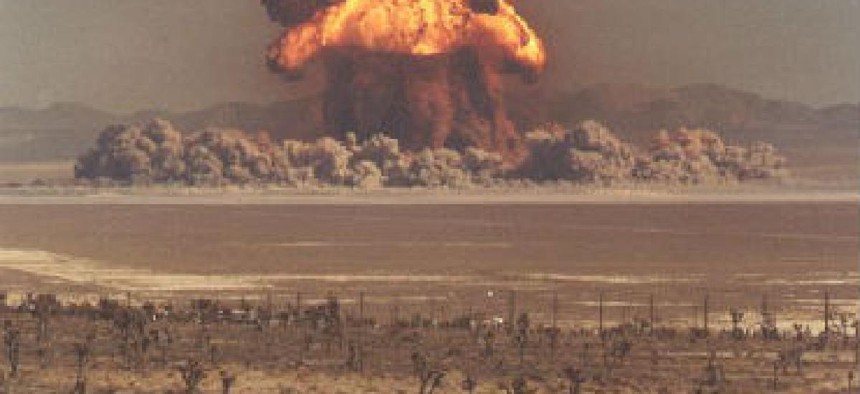A nuclear blast from the past

Vintage reel-to-reel data recorders are still spitting out telemetry on weapons tests three decades later.

A 1957 nuclear bomb explosion at the Nevada Test Site. / Trinity Atomic Web Site
The never-ending race to small continues apace, but refrigerator-sized data recorders that were once standard IT equipment on U.S. Cold War-era test ranges are still answering the call from nuclear researchers seeking information on weapon component trials.
Sandia National Lab, responsible for developing, engineering, and testing the non-nuclear components of nuclear weapons, from time-to-time still uses the magnetic tape drives originally put in place more than three decades ago to record test data.
Examples of the vintage systems, the first of which were designed in the 1950s to record telemetry generated by Sandia National Laboratory’s test ranges in the Western U.S., are now housed in an instructional facility at the lab’s New Mexico site.
The lab has a few vacuum pump-driven AMPEX reel-to-reel analog recorders in its Nuclear Weapon Legacy Hardware project that supplements Sandia/New Mexico’s Weapon Display Area and Sandia/California’s National Security Resource Center. The facilities are meant to preserve previous generations of legacy hardware for study by todays’ nuclear weapons experts.
Along with the reel-to-reel database systems, the exhibit also includes the first neutron generator designed by Sandia, a cylinder roughly a foot tall and about eight inches in diameter, which the lab said is a giant by today’s neutron generator standards. It also includes a 1951 technical and specification manual for the first Sandia-designed nuclear weapon component and the first Sandia design of a fuzing radar system.
The AMPEX recorders like those in the exhibit still see use today, Sandia’s staff said in a statement.
“We still use those machines today to recover legacy flight test data from nuclear weapons Joint Test Assemblies and to recover data from legacy underground nuclear tests,” said Gary Ashcraft of Sandia’s Enhanced Systems and Data Analysis department.
The reel-to-reel analog recorders were standard issue on telemetry ranges starting in the 1960s, although the machines in Sandia’s display date from about 1984, according to the lab.
“The machines didn’t change too much over the years in their basic operation,” said Ashcraft. “Fifty years of the same technology said a lot about how well they were designed, and many companies made them.”
One 1-inch-wide 14-track tape holds about 70 gigabytes of analog waveform data, which Ashcraft called “pretty impressive for the time.”





